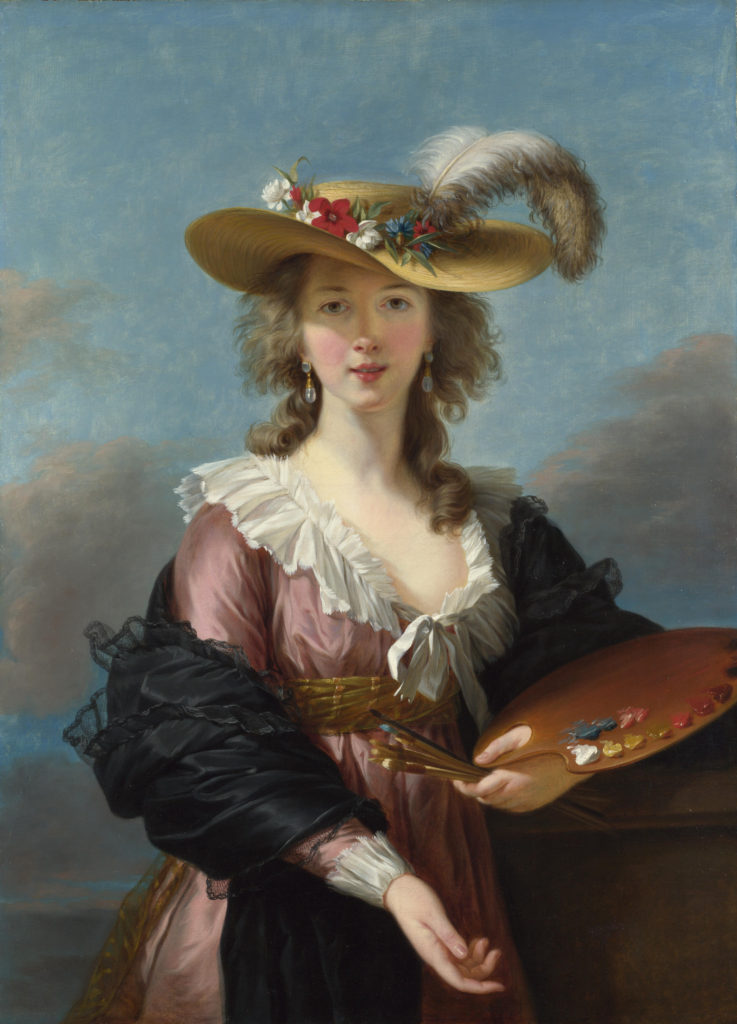“Painting is poetry that is seen rather than felt, and poetry is painting, that is felt rather than seen” – Leonardo da Vinci
The french women had felt the painting they saw and they produced several masterpieces, too. Let us talk about some of the prolific women painters. It is said that the paintings are to be seen and not to be talked about. But we are to talk about the paintings done by the women artists.
Let us start talking about the women artist of France. Woman artists of France, who lived in the eighteenth century. Let us start. Let us start with some of the renowned portrait-makers women artists.

Self Portrait in a Straw Hat
Élisabeth Louise Vigée Le Brun
Oil on Canvas,
National Gallery, Central London
Élisabeth Louise Vigée Lee Brun (1755-1842):
She was known as Madame Lee Brun, among the artists and her friends. She started her painting career early, in her teenage. But what deed she painted? she painted beautiful flowers. She painted beautiful people.
Yes, she had painted more than 600 portraits. The landscape was her favourite subjects. She had a collection of 200 landscapes. Presently, her paintings are displayed in major museums of the world.
Look at the portrait of Mohammed Dervish Khan. This painting was sold for $7.2 Million at Sotheby, in the year 2019. This sale of the portrait by Élisabeth Louise Vigée Le Brun has set a world record for a woman artists who lived before 1900.
Elisabeth had the opportunity to travel to the Netherlands, with her husband. There she observed the paintings of Flemish master artists. The Self-Portrait with Straw Hat (1782) given at the top is by Elisabeth. For this portrait, we can see that she would have got inspiration from the work of Peter Paul Ruben.
The State Hermitage Museum, Saint Petersburg, Russia; National Gallery, Central London; Metropolitan Museum of Art, New York City: these are the museums that have displayed the paintings of Madama Lee Burn. There were contemporary artists, too, who had painted portraits in the style and poses Elisabeth had done.
Look at the self-portrait of one contemporary woman artist of France, Adélaïde Labille-Guiard (1749 – 1803). We can see the influence of Elisabeth’s painting given above, in Adélaïde Labille-Guiard’s self-portrait.
Adélaïde was a wonderful artist on her own. She had painted a number of portraits and miniature portraits, too. After the French revolution, the paintings of women were also allowed to be displayed their work freely.
Adélaïde’s works had been also displayed in several exhibitions and museums. in Salon. Marie had displayed her paintings in Salon, too.

Painting of a female violinist
Anne Vallayer-Coster
Oil on canvas National Museum of
Fine Arts, Stockholm, Sweden
Anne Vallayer-Coster:
There was a river Bievre, near the river Seine. There was the home of a goldsmith. He had a golden connection with the royal family of France. Anne was born in 1744 as one of the four daughters of the said Goldsmith. Her father had a business of tapestry. Her artwork had found a way onto the tapestries produced in her father’s factory.
In eighteenth-century France, portrait painting and still-life paintings were not considered first-grade art. However, Anne accepted the challenge and created marvellous portraits. Once her family moved to Paris, her portraits and other still-life were in good demand.
Anne had friends in Royal families. But once the royal family was on the decline of its influence, Anne had suffered a setback, too. It was the days that the women were subjected to several restrictions. Art institutions were not allowing women to learn art, too. The display of the painting in a gallery was a rare event.

Self-portrait with a Harp
Oil on Canvas Rose-Adélaïde Ducreux
Metropolitan Museum of Art of New York City
Rose-Adélaïde Ducreux (1761-1802):
She was a French painter. She was a musician, too. She was born in Paris at the time of the French revolution. It was the brightest of the times in France; It was the darkest of the times in France. However, the French women and men artists kept the bell of painting ringing. Rose was one of them.
The self-portrait shown here is painted using oil on canvas. However Rose used paster colours very artistically. Here in this self-portrait, the artist is depicted along with her musical instruments. Rose had used such a colour scheme in her paintings that the viewers would find them very light and gentle to the eye.
Rose had made her debut at the Louvre Salon. It was the year 1791 when Rose had submitted this portrait Self-portrait with a Harp, wherein she was playing the harp. This painting is presently displayed in the Metropolitan Museum of Art, New York City, USA. [All the images are in Public Domain, taken from Wikimedia Commons]
Courtesy: www.paintingsgalleries.com
